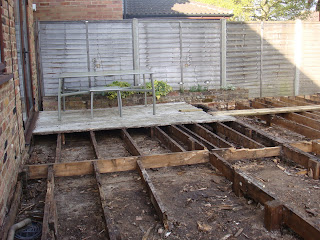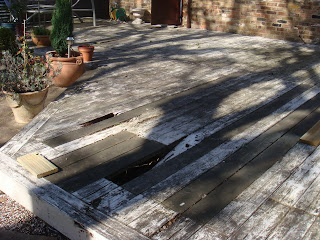Initially, during the latter part of September, there was progress with the deck, which I am now able to report on; then Jane & I were busy enjoying ourselves, including a very enjoyable trip to "Center Parcs" at Longleat; then we both came down with very bad colds which seemed to drag on for ages, and ages, and during which I did not feel like going outside much. Then, when that cleared up the weather was pretty rotten, so again not much was done outside.
Then we agreed to take up an offer from British Gas to have our cavity walls insulated, and when the surveyor came round he explained that the installers would need access to the inside house wall of our garage, the garage loft and worst of all the garage end wall in the loft inside the house. All of these areas were, of course, filled up with "stuff" that we have managed to collect over the last 25 years and we therefore needed to divert our attention, from the deck, to having a major clear out, of lofts and garage, before the installers arrived.
After that the weather went bad again, then we both came down with further colds . . . so decking activity has been somewhat slow.
However, that's enough of excuses, let's get on with the report.
So, as mentioned last time, I had ordered some more pea shingle and this is what a Jumbo Bag looks like - 850kg if you recall.
Then, just before I announced the final completion of the basic deck support structure, Jane decided that she wanted a little bit more, in the far corner near the side path entrance; so here is Jane hard at work clearing the ground in preparation for that extra area of deck support.
And here is the final result, at which point, having also completed some repair work of the damp proof concrete flashing and the re-pointing of some cement in fills round the bottom of the garage and French doors, we were finally ready to start putting the top boards in place !!
Those eagle eyed detectives amongst you may notice there appears to be a lot of leaves in this photo; this is because I forgot to take a photo of this area immediately following completion and this is a very recent (out of sequence) photo, by which time the oak trees had started to shed leaves at a serious rate! By the way the top boards in this shot are merely resting there; they are not screwed down at this point.
Anyway, as previously mentioned, once the supports are all firmly in place, actually screwing down the top boards is quite straight forward; so here is a view of the first few boards finally in place.
And here, below, is shot showing a few more boards in place; and also the tools required for this stage of the work; including tile spacers, which are great for maintaining the required 5mm gap between the boards, and lots and lots of screws, and of course deck seal which needs to be applied to each pilot hole drilled through the deck boards, and to the screws as they are finally screwed home.
And so as the year draws to a close the spread of the top boards grows quite quickly (when the weather permits).
Some time was spent between each top board fitting session in clearing away the leaves that were now falling, in order to avoid too many leaves being trapped under the deck.
The target is for completion inside the year, from first starting to rip out the old deck; I believe that should be achievable . . . so watch this space.
Merry Christmas and a Happy New Year to all.






































